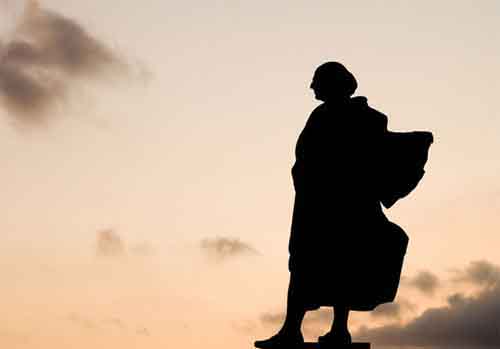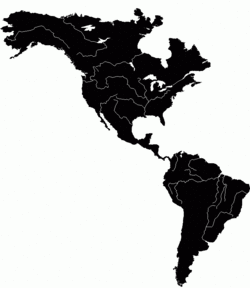
Christopher Columbus
There is speculation as to who the first people were to inhabit the American continent. Below are some current theories.
Were there only a few dozen first Americans? MSNBC - May 25, 2005
A new study of DNA suggests North America was originally settled by just a few dozen people who crossed a land bridge from Asia during the last Ice Age.
About 14,000 years ago, humans crossed the Bering land bridge from Siberia to North America, most experts agree. But just how many intrepid explorers were involved has not been known.
Previous DNA analyses of the New World's founding looked at just one gene and assumed populations sizes have been constant over time.
The new study looked at nine genomic regions to account for variations in single genes, and it assumed that sizes of founding populations change over time. The method favored actual genetic data over estimates used in previous calculations.
"The estimated effective size of the founding population for the New World is about 70 individuals," said Jody Hey, a professor of genetics at Rutgers University.
Did Prince Henry Sinclair discover America? Scotsman.com - May 20, 2005
It is 1398 and the fleet sails from Orkney on a voyage funded by the Templars to the New World. On board are Prince Henry Sinclair, Lord of Rosslyn, and the Zeno brothers, renowned Venetian sailors.
One hundred years before Christopher Columbus discovered America they reached Nova Scotia where Templar architecture and the oral history of the Mi'kmaq Indians are all that remain to inform us of this voyage. Prince Henry's death shortly after returning to Orkney meant that news of his epic journey was lost for centuries.
Attempts to bring Prince Henry's exploits back to life have been renewed in recent years. Much of the credit for this lies with Niven Sinclair, an 81-year-old businessman and Sinclair clan member who says that for 30 years he has "worked solely to finance this crusade to re-write history."
To claim that a Scottish Knight Templar first landed in North America is an enormous re-write of history or it would be if there wasn't a big question mark hanging over the historical proof.
"The whole thing is complete baloney from beginning to end," says Brian Smith, archivist with Shetland Islands Council, who has written papers on Prince Henry's voyage. "It makes me blush that people actually believe any of it."
The veracity of the voyage has become a battleground. In the red corner are those who want to hold up a mirror to history and re-write it, and those in the blue corner who demand greater historical accuracy.
"There is so much proof that the voyage happened," insists Niven Sinclair, the red corner's biggest hitter. "Unlike Brian Smith I've walked in the footsteps of Prince Henry. I have seen tonnes of documentation and there is absolutely no doubt at all about it."
The proof for the voyage seems compelling. There is the famous Zeno Narrative, a map which purports to show the journey the brothers took with a man called Zichmni (later identified by writer John Forster as Prince Henry himself). This provided the foundation for a 19th-century book by Richard Major, a well-respected geographer who suggested Prince Henry indeed reached America.
A later book by Frederick Pohl traced the actual landing spot to Guysborough, Nova Scotia. Pohl found confirmation of the voyage by studying Mi'kmaq oral history.
And there is an ancient Venetian canon, a strange carving of a knight and the Newport Tower found down the eastern seaboard from Guysborough that offer further proof.
Finally there are the carvings at Rosslyn Chapel, built near Edinburgh by the Sinclair family in 1446 and made popular by the book The Da Vinci Code, that show maize and aloe vera - plants which at that time were indigenous to North America but carved before Columbus discovered the New World in 1492.
Pretty compelling stuff, and certainly enough to convince D'Elayne and Richard Coleman who run the Prince Henry Sinclair Society of North America. They read Pohl's book, met with Niven Sinclair and were converted. Richard Coleman says he is passionate about the story because he is "interested in real history, not phoney history."
So far the Colemans say they have spent $30,000 building a monument to Prince Henry in Nova Scotia. They are also hoping to build a national park in his memory.
Ranged against them in the blue corner is Smith, the Shetland archivist who has had some robust run-ins with Niven Sinclair. Smith argues that the Newport Tower is a fully documented 17th-century tower, that the knight is even later, and argues there is more than enough evidence to prove "without a shadow of doubt that the Zeno Narrative was written in the 16th century."
Oxbrow has become increasingly concerned with the high profile the Prince Henry voyage is enjoying. More generally he is worried about stories linking the Sinclairs with the Templars.
"The problem today is that very little is actually historical," he says. "And the more publicised it gets, the more loopy it gets too."
The "loopiness" that Oxbrow is referring to is the staggering number of people who believe the Sinclairs are, variously: the keepers of the Ark of the Covenant and/or the Holy Grail, voyagers to America and descendants of Jesus Christ himself.
Niven Sinclair certainly believes that the blood of Jesus runs through his veins and that the history of the Sinclairs is an incredibly one. "You can't be anything but humbled by being a Sinclair," he enthuses.
This claim to greatness on behalf of the Sinclair clan is not supported universally. Robert Cooper, curator to the Grand Lodge of Scotland, has looked into the genealogy of the Sinclairs.
"Until recently the Sinclairs were not an important family," Cooper says. "Look at the back of any history book and they don't have many references."
Cooper gets irate when he is told that Rosslyn is a Templar church and that the Sinclairs grew rich from Templar money. He cites as an example the fact a Sinclair testified against the Templars at their Scottish trials.
So just why are a hitherto nondescript Scottish family now at the forefront of so much speculative revisionist history? Smith thinks he knows the answer.
"I always say that there is only one book that anyone needs to read," Smith says, "and that is Niven Sinclair's cheque book."
By his own admission, Niven Sinclair has spent a lot of money on the Prince Henry project. "I can't tell you how much I've spent because I would have the tax man chasing me," he confirms, "but I work in order to finance this."
Developing this new Sinclair legend may be a jolly good wheeze, but Smith says it compromises our known history in favour of a flamboyant version.
"You can't just make up the past," Smith insists.


Americas Wikipedia
ALPHABETICAL INDEX OF ALL FILES